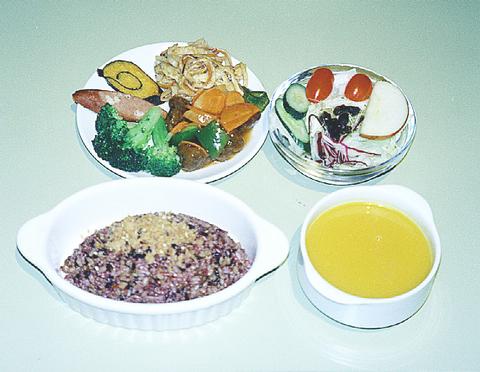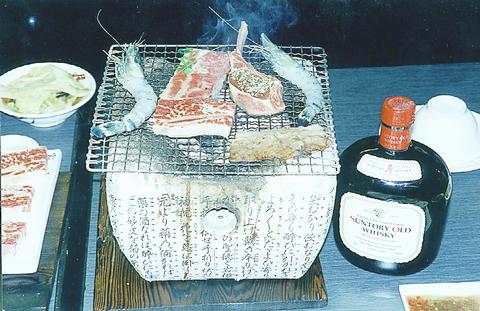Olive Tree
(Olive Tree 地中海式餐廳)
Imperial Inter-Continental Hotel Taipei, 2F, 600 Lin Shen N. Rd. (台北市林森北路600號台北華國洲際飯店二樓)

PHOTO: CHANG JU-PING
Tel: 25965111 ext. 2702
Open 11:45am-2:30pm; 6:00pm-10:30pm.
Average meal: NT$600. English menu. Credit cards accepted.

PHOTO: CHANG JU-PING
It may be premature to say that if the food looks good, it tastes good, but the dishes at this cozy restaurant, opened on April 25, look truly delicious. And best of all, the food measures up to its presentation, with a natural, non-greasy, and carefully-seasoned taste. In the short time it's been open, Olive Tree has become popular, particularly among female diners who shun overpriced "hotel restaurants."
Chef Tom Hsieh (謝宜榮), who has extensive experience at five-star hotels like Grand Hyatt Taipei and Grand Formosa Regent Taipei, says his catering includes authentic Mediterranean dishes. Hsieh does not try to produce overly sophisticated cuisine and people can make these typical Mediterranean dishes at home using the four cookbooks Hsieh has published.
The mezze buffet features over 25 dishes dishes. The cous-cous salad makes use of North African rice and zucchini prepared in Moroccan style. Hsieh also recommends the provencal potato salad. Other restaurants use mayonnaise in this dish but Hsieh opts instead for parsley, chicken and mustard to enhance the dish in a typical French style. Hsieh says his dishes are rarely found elsewhere, and usually are mixed with a variety of local and imported herbs. If the light dishes at the mezze buffet are not enough, there are also a la carte items with pasta, pizza and main courses to choose from. Seafood dishes are highly recommended. The chef in particularly thinks the Andalousian paella, with its succulent calamari, shrimps, and scallops, is a must try. The desserts are not to be overlooked, especially the raspberry creme brulee.

PHOTO: CHANG JU-PING
E2 Coffee
23, Ln. 240, Kuangfu S. Rd., Taipei(臺北市光復南路240巷23號地之華大廈).
Tel: 2776-3062
Open 7am to 11pm.
Average meal: NT$200. English menu. Credit cards not accepted.
Vegetarians looking for a nice spot to eat now finally have a place to accommodate them. E2 Coffee, opened six weeks ago, has large windows, a well-lit interior and healthy, organic food that makes this city diner wildly popular. Owner Chen Yao-tsung (
Chen emphasizes, however, that E2 is not strictly an organic food restaurant. Along with the organic rice and grains and vegetables are nine types of coffee and 10 types of herbal teas. For those who like a light and fragrant meal, try the cereal rice and vegetables Set. The rice bowl is furnished with a combination of mixed grains and different kinds of rice such as black sticky rice (黑糯米). Those who just can't do without the taste of meat should try the fish steak in Japanese style. The meat imitations are made from tofu and taste wonderful and don't have the fat. For extra pep, try the "miracle energy soup," a staple of most organic restaurants. It's a bit bitter, but is extremely healthy, and purports to restore one's energy. Chen says it is made of various kinds of fibers from vegetables, fruits and nuts. He also recommends finishing the drink within 15 minutes to maintain the freshness of the juice.
Chun-hsi Japanese Yakiniku Restaurant(春喜日式炭燒)
38 Peining Rd., Taipei (臺北市北寧路40號)
Tel: 2570-7793
Open 11:30am-2pm; 5pm-2am.
Average meal: NT$350. No English menu. Credit cards accepted.
Japanese-style barbecue is one of the novel ways of dining available at this chic, monochrome decor restaurant that opened April 1. Lawrence Lu (
Lu offers about 50 items for barbecue, including meat and vegetables. The various kinds of beef are a must try. Kobe is famous for its tender so-called "frost fall beef." There is also wu-hua beef, which has some fat in it for a richer taste. Lu also recommends French lamb chops. The three slices of tender meat are topped with Italian herbs for flavor enhancement. The sour and spicy cabbage is exceptional. An added attraction are several specials associated with the restaurant's grand opening -- buy-one-get-one-free Sapporo beer, free iced tea at noon and free soup all day.
-- chang ju-ping

This month the government ordered a one-year block of Xiaohongshu (小紅書) or Rednote, a Chinese social media platform with more than 3 million users in Taiwan. The government pointed to widespread fraud activity on the platform, along with cybersecurity failures. Officials said that they had reached out to the company and asked it to change. However, they received no response. The pro-China parties, the Chinese Nationalist Party (KMT) and Taiwan People’s Party (TPP), immediately swung into action, denouncing the ban as an attack on free speech. This “free speech” claim was then echoed by the People’s Republic of China (PRC),

Exceptions to the rule are sometimes revealing. For a brief few years, there was an emerging ideological split between the Democratic Progressive Party (DPP) and Chinese Nationalist Party (KMT) that appeared to be pushing the DPP in a direction that would be considered more liberal, and the KMT more conservative. In the previous column, “The KMT-DPP’s bureaucrat-led developmental state” (Dec. 11, page 12), we examined how Taiwan’s democratic system developed, and how both the two main parties largely accepted a similar consensus on how Taiwan should be run domestically and did not split along the left-right lines more familiar in

Specialty sandwiches loaded with the contents of an entire charcuterie board, overflowing with sauces, creams and all manner of creative add-ons, is perhaps one of the biggest global food trends of this year. From London to New York, lines form down the block for mortadella, burrata, pistachio and more stuffed between slices of fresh sourdough, rye or focaccia. To try the trend in Taipei, Munchies Mafia is for sure the spot — could this be the best sandwich in town? Carlos from Spain and Sergio from Mexico opened this spot just seven months ago. The two met working in the

Many people in Taiwan first learned about universal basic income (UBI) — the idea that the government should provide regular, no-strings-attached payments to each citizen — in 2019. While seeking the Democratic nomination for the 2020 US presidential election, Andrew Yang, a politician of Taiwanese descent, said that, if elected, he’d institute a UBI of US$1,000 per month to “get the economic boot off of people’s throats, allowing them to lift their heads up, breathe, and get excited for the future.” His campaign petered out, but the concept of UBI hasn’t gone away. Throughout the industrialized world, there are fears that